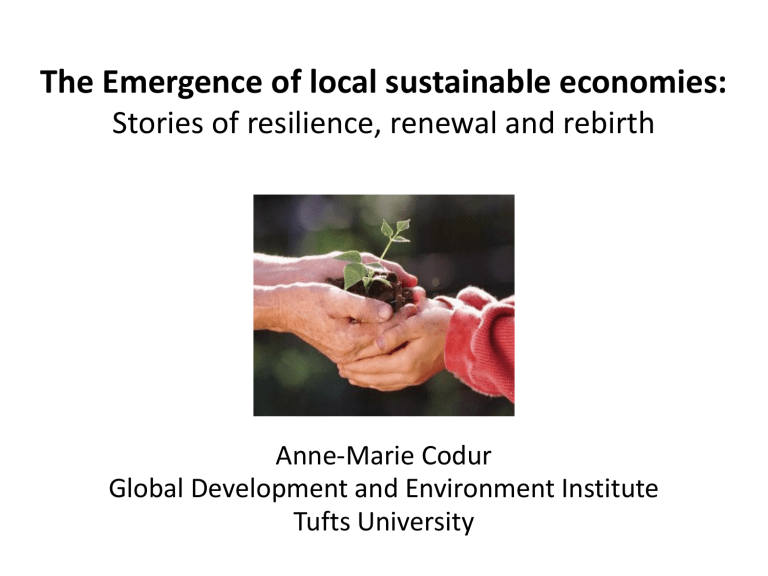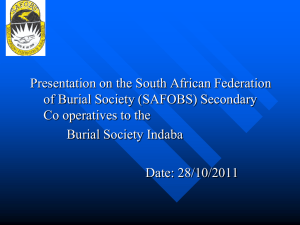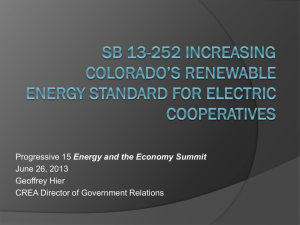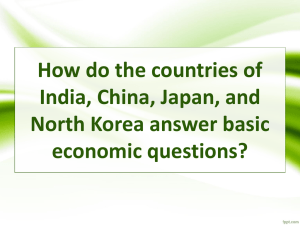The Emergence of Local Sustainable Economies

The Emergence of local sustainable economies:
Stories of resilience, renewal and rebirth
Anne-Marie Codur
Global Development and Environment Institute
Tufts University
The three systemic global crises
• Global Environmental Crisis: destruction of biodiversity
(Massive destruction of habitats - 6 th global extinction), global climate change,…
• Social Inequality and Injustice crisis: 1% people on Earth has 46% of world’s wealth – richest 300 people have the same has 3 billion people!!!!
20% of world population consumes 82.7% of global production while 20% poorest live on 1.4% of global production
• Global Financial crisis: “2008 wasn’t the real crash. The real crash is coming.” - Peter Schiff, CEO of Euro Pacific Capital
(quoted in June 2012)
Public opinions
French polling company IFOP, 2011
Do you think our current economic system is deeply dysfunctional?
Agree:
French: 52%
Germans: 42%
Americans: 32%
Do you think we ought to abandon this model for another one? Agree:
French: 33%
Italians: 22%
Germans: 12%
BBC poll, 2009
Do you think a strong public policy is needed in favor of a more equitable redistribution of wealth? Agree:
Chileans: 91%; French: 87%; Spaniards: 83%; Germans: 77%
Russians: 63%; British: 67%
Americans: 41%
GLOBAL ECONOMIC SYSTEM NEEDS TO BE REGULATED
AND GUIDED TOWARDS A STEADY-STATE…
3 scenarios
1) More and more crashes and catastrophes… resulting in a « Fortress world » of the few against the masses of destitute people in a devastated planet: see Sci Fi movie
« Elysium »
2) EMERGENCE OF A GLOBAL GOVERNANCE SYSTEM ?
(but G8, G20 have shown their limitations and national governments have lost ability to exert control on global financial markets and global corporations)
3) EMERGENCE OF MILLIONS OF INITIATIVES FROM THE
GROUND UP…
EMERGENCE OF
LOCAL SUSTAINABLE ECONOMIES
Socio-ecosystem’s vital flows
MONEY: enabler of vital exchanges
Solar energy biomass
Labor
Socio-ecosystem
Families, communities,
Firms, organizations,
Natural ecosystem
Energy water nutrients water
Institutions, governance system
Land/Food production
Other basic
Resources
Local solutions to Global crises
ACCESS TO BASIC RESOURCES: WATER, FOOD, ENERGY
Re-appropriation by local users of systems of natural resources:
Ex: community-owned water systems
• Re-orientation of food production towards more self-sufficiency of local communities: slow food models
• Harnessing locally renewable energies, solar, wind, geothermic
WORK: Emergence of socially equitable forms of organizations: worker cooperatives
MONEY: EMERGENCE OF LOCAL COMPLEMENTARY CURRENCIES community-based currencies to re-energize local flow of exchanges among people deprived of monetary means, to use underutilized resources (unemployed or under-employed people) and to re-create social ties of solidarity between people
WATER
The threat of losing access to common goods: global corporations’ water grab
Cochabamba, Bolivia
Re-creating collective systems of management of the commons
The acequias of New
Mexico are communal irrigation canals, a way to share water for agriculture in a dry land.
Tiwa Indians irrigated farmland in the area as long as 1.300 years ago.
“Communities have relied on institutions resembling neither the state nor the market to govern some resource systems with reasonable degrees of success over long periods of time ” Elinor Ostrom, in “Governing the Commons” (1990)
Felton, California
• 2002: Felton water system sold to California
American Water Co. (Cal-Am), a subsidiary of
RWE Aktiengesellschaft - the third largest water company in the world. RWE filed for a
74% rate increase. Cal-Am has a monopoly on the water delivery system and the Public Utility
Commission guarantees Cal-Am an 11% profit
• In 2003, residents form a coalition to buy back their water resources to Cal-Am – at ballot,
75% voters voted YES – A six-year legal battle ensued
• In 2008 Felton citizens won back their water
• Inspired dozens of other towns to do the same
FOOD
Indian farmers vs. Green revolution: Resist the privatization of crops’ genetic pool
March against Monsanto, New Delhi, May 25, 2013: loosing their lands to debt (caused by high prices of GMO seeds, fertilizers, pesticides, etc…)
200,000 Indian farmers killed themselves since 1997
Vandana Shiva: the seeds belong to the farmer!
The keepers of seed banks:
“ I might be illiterate but I can argue with any scientist that I can produce with those free seeds and some organic manure a much healthier food than with those modern seeds that are so expensive and those chemicals that are exhausting the soils”
- Chandramma, 58 year old woman from Medak,
Andhra Pradesh, India
Stopping Food, Inc.
• USA, July 4, 2013
• Dakar, Senegal, Feb. 7, 2011: NO TO AGRA!
(Alliance for a Green revolution in Africa is promoted by Rockefeller
& Gates foundations)
Farmers’ response:
WE ARE THE SOLUTION
Celebrating African Family Farming!
Urban agriculture in Detroit
We want to help make Motown a thriving Growtown”
B
Beekeepers inspect a bee-laden frame from a hive at Detroit’s D-Town Farm
The New Food revolution?
Carlo Petrini, pioneer of the Slow Food movement
Can organic farming feed the world?
“when best management practices are used for organic crops, overall yields are just 13% lower than conventional levels”
Research has shown that organic agriculture, if practiced on the earth’s 1.4 billion tillable hectares, could sequester nearly 40% of current CO2 emissions
Comparing the yields of organic and conventional agriculture. Nature,
2012
Tim de la Salle, “Regenerative
Organic Farming: A solution to
Global Farming”, Rodale Institute
2008
Permaculture home
ENERGY
Harnessing renewable energies locally
Transition Towns: Marlow, UK – establishing 100 solar panels in their town – as a community project
Harnessing solar energy in Africa
Solar Sister is a social enterprise business
Our mission is to empower women with economic opportunity and eradicate energy poverty. We use a market based program to distribute solar technology that provides income to women entrepreneurs and is the most effective distribution for new technology to rural households.
WORK
A man-made common resource: the worker-owned cooperative model
1843 – founding of Rochdale equitable pioneers society
1934 Upton Sinclair’s electoral program to end poverty in
California by seizing idle factories and farm land where the owner had failed to pay property taxes – and transform them into self-sufficient, worker-run co-ops
Mondragon cooperatives,
Basque country, Spain
Father Arizmendiarrieta, founder of the Mondragon cooperatives (1954)
From Argentina economic crisis (1999-2002) and its Empresas recuperadas…
By 2003, there were 170
“recovered” firms employing more than 9000 workers in Argentina
…To the revival of Cleveland’s inner city neighborhoods through the Evergreen cooperatives
The largest female cooperative in the world
• Started in 1959 with a seed capital of Rs. 80, Lijjat had an annual turnover of around Rs. 650 (over $100 million) in 2010
• Started with the hand-made production of Papad, the popular indian crispy bread, by thousands of poor urban women to provide them with sustainable livelihood
• It provides employment to around 42,000 people.
Cooperatives that empower women
Production of olive oil, and argan oil (used in cosmetics) by women-owned cooperatives in
Morocco
MONEY
Nurturing the local economy through community-based currencies
National/global banks
Money flows “leaking out” from local to global system
Conventional money
Food, Housing, Health,
Education, Basic goods and services
Access to
Local Socio-economic system
Markets of
Reconnecting people together goods,
People with resources services, local currencies factors of prod
Access to unemployed
Impoverished families
Social gap between have and have not
Local currencies as resilience strategy
Local Exchange Trading System (LETS)
• The function of the LETSystem
The LETSystem is an economic system intentionally designed to address the problems and limitations of conventional money.
Rather than proposing a replacement for conventional money, the LETSystem is designed to integrate with all aspects of economic and financial life. It is a complementary system rather than an alternative one.
Système d’Echange Local : SEL
TIME BANKS
One hour of person A = One hour of person B
Recreates equality in the economy
Can be used to address unmet needs of services that require lots of time: elder care, children care
=> Rebuilds social ties of solidarity between people
The Nayahan Banjar system in Bali: an ancient time bank
Japan Fureai Kippu Time Banking for elderly care
Investing in local economies: towards community capitalism
What would the world be like if we invested 50% of our assets within 50 miles of where we live?
every dollar spent at a locally owned business generates two to four times more economic benefit— measured in income, wealth, jobs, and tax revenue—
than a dollar spent at a globally owned business. That is because locally owned businesses spend much more of their money locally and thereby pump up the socalled economic multiplier.
- Michael Shuman
“Plugging the leaks”
New Economics Foundation (UK) framework to help towns and local communities to maximize multiplier effect of local investments inside the
Community and avoid too much
“leaking” outside
Develop projects and strategies which
encourage the local cycling of money.
These could be local currencies, Time
Banks, Credit Unions or a range of other strategies.
To summarize…
Human beings
Relations between them
Environment
Relations between Humans and Environment
Global Mainstream Economy
Inputs = HR – are disposable, laid off when are of no use
Consumers of outputs , ensnared by advertisement to consume always more…
None. Producers and consumers are disconnected, atomized, anonymous individuals
Workers, under constant threat of being laid off, are discouraged to join unions
Millions of “streams” of local sustainable economies
Family, neighbors, community
Caring for each other : recreating networks of activity where everyone is useful
Community’s values shape consumption decisions
Networks of people who know and trust each other – close relations between producers and consumers
(often the same people!) no more than 1 degree of separation…
Input and sink
Disconnected – food production is industrialized, seeds are owned by corporations, water is privatized, etc…
Home: where people live, which they need to protect for themselves and their children
Close interconnections – organic gardening, re-appropriating ancestral customs, protect biodiversity of seeds, recreating local governance of natural commons, water systems,…
Main economic actors
Time
Growth
Energy
Investment
Currencies
Governance
Global Mainstream Economy
Multinational Corporations
Millions of “streams” of local sustainable economies
Small-scale enterprises, cooperatives of citizens/workers/shareholders
Fast, accelerating pace Slow pace
Absolutely needed or the whole system is in crisis
High levels, and increasing levels are needed
High levels of accumulation in corporate financial institutions/stock markets – with high risks of instability
Not necessary, especially if no demographic growth
Low levels – increasingly provided locally by renewable sources (wind, solar, geothermal)
Local small-scale investment, crowdsourcing by pooling people’s resources
Global currencies, increasingly vulnerable to crisis (Euro-zone)
Resilience strategy: Emergence of local currencies, time banks, and other nonmonetary systems of exchanges
Concentration of power in fewer hands.
Democratic Deficit – national governments and elected officials increasingly powerless
Vibrant local democracies, high level of participation/commitment from citizens in the design and implementation of their local policies
Conclusion
Emergence of alternative economic models:
Combining the best of globalization: networks of communication, information, global social networks of citizens (Facebook, twitter, global community of bloggers…)
With resilient sustainable forms of local socioeconomic systems (food, water, energy, local governance, cooperatives, housing,…)
Question:
Where is the tipping point? When does the critical mass of all of these local alternative systems start coalescing into a global network of local systems?








